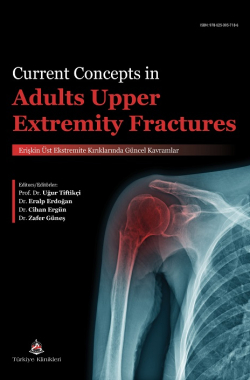THE NATURAL HEALING PROCESSOF FRACTURED BONES AND SUPPORTIVE THERAPIES
Ekin Kaya Şimşek1 Maksat Artykov2
1Ankara Başkent University, Faculty of Medicine, Ankara Hospital, Department of Orthopedics and Traumatology, Ankara, Türkiye
2Ankara Başkent University, Faculty of Medicine, Ankara Hospital, Department of Orthopedics and Traumatology, Ankara, Türkiye
Şimşek EK, Artykov M. The Natural Healing Process of Fractured Bones and Supportive Therapies. In: Tiftikçi U, Erdoğan E, Ergün C, Güneş Z, editors. Current Concepts in Adults Upper Extremity Fractures. 1st ed. Ankara: Türkiye Klinikleri; 2025. p.387-395.
ABSTRACT
The subsequent chapter delivers a comprehensive overview of the natural bone healing process following fractures, along with various adjunctive therapies that can enhance and expedite recovery. Bone healing is a complex biological and biomechanical progression encompassing a series of well-coordinated stages: inflammation, soft callus formation, hard callus formation, and remodeling. Each stage is imperative for reinstating bone integrity and functionality. The initial inflammatory response culminates in hematoma formation, serving as the foundation for subsequent healing. This is followed by the development of soft callus tissue, which stabilizes the fracture, progressing to the hard callus stage, where woven bone begins bridging the fracture gap. Ultimately, the remodeling phase replaces immature bone with organized lamellar bone, thereby restoring the bone’s original structure and strength. Furthermore, the chapter delineates the contrast between direct (primary) and indirect (secondary) bone healing mechanisms, underscoring the requisite conditions for each. Direct healing, occurring without callus formation, necessitates complete mechanical stability and precise alignment of bone fragments. In contrast, indirect healing entails callus formation and represents the body’s natural response to fractures with some degree of movement between fragments. In addition to these biological processes, the chapter investigates adjunctive treatments that can optimize fracture healing. Mechanical stimulation methods, including axial micromovement and vibration, have shown potential in expediting healing by fostering critical cellular responses essential to bone regeneration. Electromagnetic therapies, such as pulsed electromagnetic field therapy (PEMF) and direct electrical stimulation, are also deliberated for their capacity to enhance bone repair by stimulating osteogenic activity. Pharmacological interventions, encompassing growth factors, parathyroid hormone (PTH), and platelet-rich plasma (PRP), are examined for their roles in promoting swifter and more efficient healing. Furthermore, the passage addresses the use of orthobiologics, such as mesenchymal stem cells (MSCs) and tissue engineering scaffolds, offering promising avenues for enhancing bone regeneration, particularly in cases of delayed healing or nonunion. Overall, this chapter furnishes pivotal insights into the factors influencing bone healing while presenting emerging therapies aimed at improving outcomes in patients with fractures, especially those at risk for delayed healing due to comorbidities or other complications.
Keywords: Bone healing; Fracture repair; Callus formation; Mechanical stimulation; Electromagnetic therapy; Orthobiologics; Mesenchymal stem cells; Growth factors
Kaynak Göster
Referanslar
- ElHawary H, Baradaran A, Abi-Rafeh J, Vorstenbosch J, Xu L, Efanov JI. Bone Healing and Inflammation: Principles of Fracture and Repair. Semin Plast Surg. 2021;35(3):198-203. [Crossref] [PubMed] [PMC]
- Mark H, Penington A, Nannmark U, Morrison W, Messina A. Microvascular invasion during endochondral ossification in experimental fractures in rats. Bone. 2004;35(2):535-42. [Crossref] [PubMed]
- Wildemann B, Schmidmaier G, Brenner N, et al. Quantification, localization, and expression of IGF-I and TGF-be Şimşek, Artykov The Natural Healing Process of Fractured Bones and Supportive Therapies ta1 during growth factor-stimulated fracture healing. Calcif Tissue Int. 2004;74(4):388-97. [Crossref] [PubMed]
- Thompson Z, Miclau T, Hu D, Helms JA. A model for intramembranous ossification during fracture healing. J Orthop Res. 2002;20(5):1091-8. [Crossref] [PubMed]
- Ganse B. Methods to accelerate fracture healing a narrative review from a clinical perspective. Front Immunol. 2024;15(1384783. [Crossref] [PubMed] [PMC]
- Jamal MS, Hurley ET, Asad H, Asad A, Taneja T. The role of Platelet Rich Plasma and other orthobiologics in bone healing and fracture management: A systematic review. J Clin Orthop Trauma. 2022;25(101759. [Crossref] [PubMed] [PMC]
- Steppe L, Megafu M, Tschaffon-Muller MEA, Ignatius A, Haffner-Luntzer M. Fracture healing research: Recent insights. Bone Rep. 2023;19(101686. [Crossref] [PubMed] [PMC]
- Moazen M, Calder P, Koroma P, Wright J, Taylor S, Blunn G. An experimental evaluation of fracture movement in two alternative tibial fracture fixation models using a vibrating platform. Proc Inst Mech Eng H. 2019;233(5):595-599. [Crossref] [PubMed]
- Mittermayr R, Haffner N, Feichtinger X, Schaden W. The role of shockwaves in the enhancement of bone repair from basic principles to clinical application. Injury. 2021;52 Suppl 2(S84-S90). [Crossref] [PubMed]
- Griffin XL, Costa ML, Parsons N, Smith N. Electromagnetic field stimulation for treating delayed union or nonunion of long bone fractures in adults. Cochrane Database Syst Rev. 2011;4):CD008471. [Crossref]
- Maffiuletti NA, Green DA, Vaz MA, Dirks ML. Neuromuscular Electrical Stimulation as a Potential Countermeasure for Skeletal Muscle Atrophy and Weakness During Human Spaceflight. Front Physiol. 2019;10(1031). [Crossref] [PubMed] [PMC]
- Peichl P, Holzer LA, Maier R, Holzer G. Parathyroid hormone 1-84 accelerates fracture-healing in pubic bones of elderly osteoporotic women. J Bone Joint Surg Am. 2011;93(17):1583-7. [Crossref] [PubMed]
- Govender S, Csimma C, Genant HK, et al. Recombinant human bone morphogenetic protein-2 for treatment of open tibial fractures: a prospective, controlled, randomized study of four hundred and fifty patients. J Bone Joint Surg Am. 2002;84(12):2123-34. [Crossref] [PubMed]
- Mavrogenis AF, Karampikas V, Zikopoulos A, et al. Orthobiologics: a review. Int Orthop. 2023;47(7):1645-1662. [Crossref] [PubMed]
- Thum T, Hoeber S, Froese S, et al. Age-dependent impairment of endothelial progenitor cells is corrected by growth-hormone-mediated increase of insulin-like growth-factor-1. Circ Res. 2007;100(3):434-43. [Crossref] [PubMed]
- Rezwan K, Chen QZ, Blaker JJ, Boccaccini AR. Biodegradable and bioactive porous polymer/inorganic composite scaffolds for bone tissue engineering. Biomaterials. 2006;27(18):3413-31. [Crossref] [PubMed]
- Fan J, Abedi-Dorcheh K, Sadat Vaziri A, et al. A Review of Recent Advances in Natural Polymer-Based Scaffolds for Musculoskeletal Tissue Engineering. Polymers (Basel). 2022;14(10):2097. [Crossref] [PubMed] [PMC]

